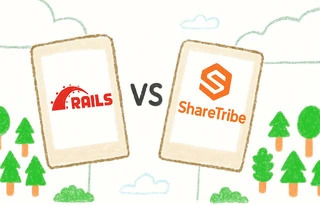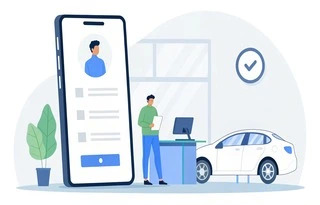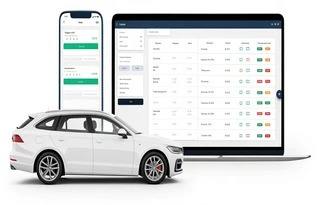The popularity of online shopping is growing every year. In 2024, global e-commerce retail sales are projected to total approximately $6.3 trillion. This figure represents an 8.76% increase from the previous year, highlighting the continued growth of online shopping as a significant portion of global retail. Experts predict that by 2026 the figure will grow to an impressive $8.1 trillion, with as much as 67% of industry sales coming from marketplaces! If you're looking to build a trading platform, now is the best time. You can capitalize on e-commerce marketplace trends and gain the attention of a wide online audience. We have gathered for you the major trends that will retain relevance in the coming year.
TOP digital marketplace trends 2025

1. Chatbots
This is one of the important marketplace trends of 2024 that will definitely remain in demand in the next few years. As of 2024, about 54% of companies are already utilizing some form of chatbot technology for customer interactions, ranging from simple rule-based bots to advanced conversational AI systems. For marketplace owners, it's an opportunity to engage with their online audience in real-time. There are three types of technology to meet the challenges of the industry:
- Based on artificial intelligence. The bot uses conversational AI, which in turn works thanks to NLP and machine learning. Key features: self-learning, "interlocutor" language recognition, and phrase generation based on previous experience.
- Rule-based. The chatbot "knows" in advance the answers to certain questions that a website visitor might ask.
- Hybrid. The technology combines both of the previous types, i.e., it uses both AI capabilities and specified rules.
Technology is important for the development of marketplaces. It helps save time consulting customers, collecting their data for marketing purposes, and even automating sales. The latter is possible thanks to accompanying the customer on the path to purchase and personalizing the customer experience.

2. Augmented reality
AR is on the list of current marketplace development trends. Its use has brought profit to many well-known companies, including IKEA. The retail chain was a pioneer in the niche, offering customers a glimpse of how furniture would look in a room on a smartphone screen.
Popular ways to use AR for online shopping:
- Trying things on. The customer can "try on" the desired item using the camera on a smartphone or other device and then decide on the purchase. Especially convenient for sellers of clothes, shoes, and accessories.
- Interactive reviews. A website visitor scans the product and accesses a product review demonstrating its features and how it works. This increases customer engagement and reduces the burden on consultants.
- Placing a product in a real environment. The potential customer can visualize the item in their home and evaluate the feasibility of the purchase. In addition to furniture, it is suitable for home and interior accessories.
More than 61% of consumers now prefer to shop from retailers that offer augmented reality (AR) capabilities. This shift reflects the growing trend of integrating AR into the shopping experience, allowing customers to visualize products in real-time and customize their selections. In 2024, 71% of shoppers indicated they would visit stores more frequently if AR options were available, highlighting its significant impact on consumer behavior and engagement. If you want to win the favor of your audience and increase their loyalty, include this technology in your list of marketplace trends. We are confident that you will benefit from it, as we have extensive experience in implementing AR-based projects.

3. Voice commerce
It is one of those global marketplace trends that has appeared relatively recently but has quickly become in demand in the niche. Of course, voice search has been known before, but it was primarily used for searching in apps and search engines like Google.
Voice technology has gone further and now allows users to make online purchases, namely:
- Personalized recommendations: Voice assistants use AI to analyze users' shopping preferences and habits, offering customized product suggestions, making shopping more relevant and efficient.
- Instant order tracking: Users can track the status of their orders simply by asking, such as "Where is my order?" This feature enhances customer satisfaction by providing real-time updates on deliveries.
- Hands-free shopping: Voice technology enables users to make purchases while performing other tasks. For example, saying "Order more laundry detergent" prompts the assistant to place an order based on past purchases.
For customers, this means a faster and more convenient shopping experience and additional profits for online platform owners. The main thing is to optimize content according to frequent queries so that users can identify texts on your site. Given the niche value of voice commerce, it can safely be included among future trends in the marketplace industry.

4. Smart recommendations
AI has not left shopping trend lists for a long time, which is due to its wide-ranging capabilities for websites. Generating recommendations is one of them. AI analyzes users' actions and makes relevant offers for them in real-time. This is possible not only for frequent shoppers but also for new and anonymous visitors.
Recommendations are generated for each customer based on their behavior. For example, in which category they browse, whether they pay attention to related products, etc. As a result, intelligent mechanisms generate suggestions that correspond to the user's steps on the buying journey.
This is one of the important online marketplace trends for platforms with many products, including niche positions. This approach leads to higher conversions and increases the chances of success in cross-selling and incremental sales.

5. Search products by image
Another one of the top developing marketplace trends based on ML and DL technologies. Website visitors can search for similar (or the same) products using the image search function. The system analyzes the visuals and compares them to all of the catalog options, then displays the relevant items. This is especially valuable for a vertical marketplace with products from the same sector.
All parties benefit from it. Website visitors can find what they need faster and at a nicer price. And you, as the platform owner, increase the efficiency of your sales management, increase the number of orders and motivate customers to come back to you again and again.

6. Digital payment methods
In 2024, the shopping cart abandonment rate is approximately 73.94%, meaning that nearly three-quarters of online shoppers do not complete their purchases and leave their carts full. The reason for the loss of customers may be the complicated ordering process and the lack of modern payment methods. Recent changes in the marketplace development due to the COVID-19 outbreak played a role here, namely the mass transition to digital payments.
The latest trends for marketplaces include the introduction of payment gateways Google Pay, Apple Pay, Amazon Pay, PayPal, and Stripe. Digital and mobile wallets lead the list of online payment methods. Credit cards are in second place, although their popularity may decline in the coming years.
It is impossible not to think about cryptocurrency. Many major players, such as Starbucks and PayPal, already accept it as payment. Although it is difficult to make predictions, it is wise to adopt this experience and implement it on a platform in the near future.

7. Omnichannel
Companies that use three or more channels for marketing get nearly 287% more orders than those that stick to one channel. This is possible because of constant interaction and rapid adaptation to customer preferences and interests.
The introduction of omnichannel experience allows:
- Be aware of the target audience's needs and motivate them to buy in time.
- Learn more about customers for marketing purposes, such as demographic characteristics and location.
- Regularly perform trend research on social media and other popular platforms.
You can use different channels to achieve different goals. For example, chat on the website to answer questions, FB to publish news, and Instagram for influencer marketing. All of these allow you to build and maintain a connection with your audience. Not surprisingly, omnichannel has made it into the marketplace predictions for 2025.

8. Live shopping
Another trend that deserves attention is live commerce. This is a sales format in which the presenter demonstrates the viewer's product and answers their questions live. Users can make purchases instantly with one click. Broadcasts are usually held on the sites of online stores, marketplaces, and brands.
This format increases audience engagement because it has not only a selling but also an entertainment component. Viewers are not just looking at a picture but at an interactive product card. Alibaba, the Chinese industry giant, has proved the fact that it changes the shopping experience. The introduction of Taobao Live in 2016 was a new step in sales.
McKinsey predicts that by 2026 this sales format could reach up to 20% of e-commerce volume. Live shopping is often called the future of online marketplaces because the conversion rate of such purchases is about 30%. This is 10 times higher than conventional e-commerce!

9. IoT
With the advent of this technology, the e-commerce space began to change. Smart devices have found use in different areas of marketplaces: logistics, inventory management, maintenance, analytics, and many others.
As an example of the use of IoT in the industry, we can cite the unlocking/locking doors of rented premises and vehicles depending on the state of the armor. It is possible to control access (grant, deny, restrict) remotely from a mobile device via an app. This is a useful feature for carsharing services and residential and commercial rental marketplaces.
Many companies prefer integrating IoT with corporate ERP systems to simplify internal processes and control. In any case, introducing such capabilities into the business is beneficial in the long run.

10. Data security
Marketplaces collect, process, and store a lot of data needed for direct identification (names, email addresses, shipping addresses), financial transactions (payment cards), and indirect identification (IP addresses, cookies) of users.
To ensure the security of personal information (PII), a marketplace must comply with a number of requirements. In the EEU, the GDPR defines them. It applies not only to businesses that operate in the area but also to businesses that supply goods/services to EU countries and process resident data. If we talk about the U.S., there are laws at the state level (CCPA, CDPA, CPA, etc.).
We should also not forget about protecting payment card holders' data: the PCI DSS standard is mandatory for businesses that manage credit card transactions.
Compliance with requirements and standards is one of the main goals for the owner of an e-commerce platform because the success of building a trusting relationship with customers depends directly on it.

11. Emphasis on trust between marketplaces and customers
Internet users visiting your platform for the first time may be wary of it. Your task is to make every visitor to the marketplace feel confident and not worry about the security of their transactions.
Important factors on which user confidence in the marketplace depends:
- Convenience and security of e-payments: use of global networks Visa and Mastercard, well-known payment gateways Stripe, Paypal, Worldpay, as well as digital wallets.
- Shopping assistance: a customer support team that is present in all communication channels and can answer any questions if needed.
- Information about data processing: a description of what user data and how it will be collected and processed within the marketplace, as well as a mandatory request for permission to do so.
- Social proof: an opportunity for the website visitor to read other buyers' reviews and evaluate the actual rating of each store.
- Direct communication: the opportunity to contact the seller directly to get useful information about the product of interest.
These are just a few factors that affect your trading platform's credibility. You can implement other initiatives according to the needs of your target audience. For example, if self-service is important to them, it makes sense to take care not only of the support team but also to add a chatbot and a section with answers to frequent questions.

FAQ marketplace trends
1. What are the current trends in the marketplace?
Businesses are now particularly active in adopting chatbots, smart search, smart recommendations, and omnichannel to personalize the user experience. IoT capabilities are widely used to improve internal processes.
2. What trends are shaping the marketplace?
The success of a business depends on its ability to adapt to customers when it comes to buying, shipping, and paying, connecting with them across all channels. This underscores the importance of personalizing the customer experience through AI, MO, and AR, expanding digital payment options, and introducing omnichannel.
3. What examples of changes in the marketplace?
Due to the COVID-19 outbreak, trading platforms have massively started to introduce digital and mobile wallets for contactless payment. Some have already switched to cryptocurrency. Live sales and voice commerce have also increased in recent years.
4. What is the future of the marketplace?
In 3 years, global retail sales could be $8.1 trillion, $2.9 trillion more than in 2021. And one of the main platforms for trade will be the marketplace.
5. How do businesses predict trends in the marketplace?
To define marketplace trends, we need to analyze what matters most to the audience of online shoppers. Personalized shopping, contactless experience, and increased security are essential to customers now, so every technology that allows this to be achieved will remain relevant in the coming year.
Want to take the first step? Get in touch!










